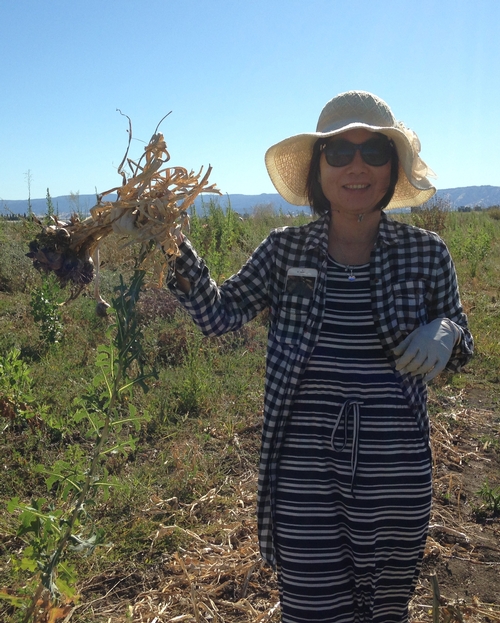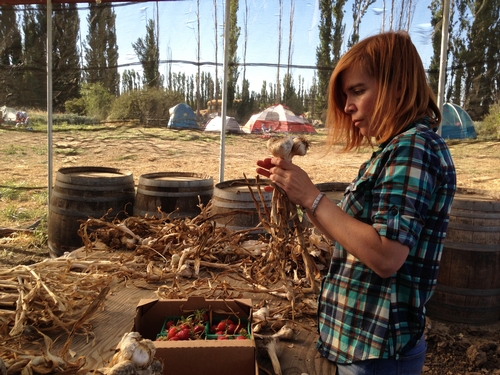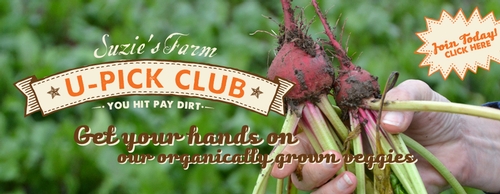
Posts Tagged: CSA
Customer Engagement: U-Pick Membership Programs
The people of Suzie's Farm, diversified organic growers in San Diego, have explored many ways to connect their customers to the farm and the good food growing on the farm. They offer regular farm tours, a CSA program, strawberry U-Pick days, farm dinners and other events. About a year ago, farm manager Lauren Gagliano Saline and her staff noticed that some of their customers wanted more chances to get their hands dirty, maybe to harvest their own CSA.
Suzie's staff tried an unguided vegetable U-Pick, letting customers pick vegetables from the fields. That didn't work out so well. Many people didn't know how to walk in the fields without trashing the beds, and didn't know how to harvest the different crops, and the random picking adventures tied up staff time. So Lauren and the team created a guided U-Pick option, and the U-Pick Harvest Club was born.
Now about fifty U-Pick Harvest Club members pick their own CSA every week. They join and prepay for four, eight, sixteen or more "picks". Each "pick" is a varying list of eight items with a set quantity of each item, designed to be approximately equal to a CSA share. Harvest Club members are told the times each week that they can pick their shares, on Tuesday, Saturday or Sunday. The picking times are when farm staff are leading their regular farm tours, so Harvest Club members join any of the tours and are supervised in their picking by the tour leaders. Of course they are not charged for the tour, which usually costs $10 per person.
Another advantage the U-Pick Harvest Club members enjoy is the chance to customize their pick, an option not available to regular CSA members. Rather than picking a set amount of each of the eight items, they are allowed to substitute more of one crop if they prefer. For example, they can pick eight melons one week if melons are one of the listed items, and take none of the other things on the list. And some people, Lauren explained, just prefer to pick that perfect bunch of kale. Harvest Club members are also allowed to bring along up to three people to "help" them pick - which includes the free farm tour.
The first year of Suzie's U-Pick Harvest Club has been a success, seeing steady growth and renewals for the second year. For more information, see Suzie's Farm website.

About four years ago, the Olsons set up a "U-pick/CSA Member Program," and now reserve the u-pick experience for farm CSA members. The price of membership is a case of Gabriel Farm's organic juice. For $36, customers get three gallons of juice and the ability to pick and purchase whatever is in season. Once they had the membership program established, Lucy and Torrey felt comfortable in opening up the U-Pick options to their full range of crops - from apples, pluots, berries, Asian Pears, tomatoes and flowers in August through persimmons and pineapple guavas in November.
Membership in the U-pick CSA program at Gabriel Farm averages about 500 families. A membership is good for a family or for a group of four people. Most customers are families with young children who want their children to learn where their food comes from and to be able to experience the farm. Most drive an hour or two from the greater San Francisco Bay Area. Lucy and Torrey are happy with their program. They have found that most people who make the membership commitment are supportive, kind and respectful of the farm.
Most U-Pick CSA members only come out to the farm once a year, as they are very busy people, Lucy explained, although she encourages all members to experience the apple harvest at least once if they start in a different season. Turnover in the program is about 80 percent, but enough new members join each year to maintain the average membership numbers.
The Olsons are not trying to grow their U-Pick program. They tried a hay pyramid one year for the children to play on, but decided that they didn't want to be in the agri-tainment business and did not repeat the experiment. They plan to continue to use the U-Pick membership program to limit the number of customers and to make more of a connection with people who enjoy and respect Gabriel Farm. For more information, see gabrielfarm.com/portal/u-pick
Customer Engagement: Garlic Braiding Party at Eatwell Farm
Nigel and Lorraine of Eatwell Farm in Dixon go an extra mile to share a taste of real farm experiences with their 500 CSA members and their friends and relations, partly for increased understanding about the farm by their customers and partly to build loyalty and attract new CSA members.

After arriving and getting settled, we all walked out to the garlic field, where we learned how to pull up the bulbs with the stem still attached. We got the hang of garlic harvesting quickly, as the soil had already been loosened around the bulbs, making pulling pretty easy. We picked and pulled and shook off the dirt and piled our findings into harvesting trays to bring back to the packing shed.
After we'd filled a dozen or so trays with our harvest, Connie and Eric, our hosts for the afternoon, let us loose in the next field over, the most beautiful abundant strawberry patch, with instructions to taste and pick what we wanted. No prices, no weighing, just picking and eating of the most delicious ripe and sweet berries. Smiles were everywhere.

Then it was time to learn how to braid. First a little instruction in cleaning off the outer layers of skins, then a short demo on how to braid, and we were ready. We all made a few braids, or tried to make braids. Although the farm sells garlic at their farmers' markets, Connie and Eric again let us know that we could take home as much as we wanted! We felt royally gifted with kindness.
Finally, dinner was ready. The main course was farm-raised chicken, prepared by Lorraine. Rounding out the delicious meal were potluck salads, sides and sweets brought by the visitors. Dinner was followed by a campfire, complete with marshmallows and all the makings for classic s'mores.


camping
Subscribing to vegetables adds diversity to the menu

"We've heard some people say when the box gets delivered, it's almost like Christmas. The kids unpack it and they get very excited," Ryan Galt, professor in the Department of Human and Community Development at UC Davis.
But subscribers should understand being a member of a CSA is not the same as going to the grocery store for their produce. Some suggestions from the experts:
- Be aware there's more growing on vegetable farms than just carrots and potatoes
- Be willing to take risks in the kitchen
- Take time to research recipes and to cook
- Because some farmers need up-front money to start the season, you may have to pay a substantial sum before receiving produce
- Food is provided strictly in season for the farm, so don't expect asparagus in September
Galt said it's also worth asking how the farm is doing financially for committing to the CSA.
"It's hard to ask because it's not a normal conversation topic in the U.S.," he said, adding that the point of CSAs in the beginning was the community figuring out how to help small farmers survive. "Farming is extremely difficult on all ends."
Larger CSAs are typically diversified businesses
A community support agriculture farm (CSA) with a large customer base generally makes a large part of its income selling through more traditional channels, reported Grace Hood on the NPR program The Salt: What's on Your Plate.
The reporter included a comment in the story from Ryan Galt, professor in the Department of Human and Community Development at UC Davis. Galt conducted a study of CSAs in the Central Valley
"Very often the larger farms [with CSAs] actually have a smaller percent of their sales from CSAs," because they have other, bigger points of sales, Galt said. "They're more likely to rely on a huge number of different outlets: farmers markets, CSAs, direct to restaurant, direct to retail and also wholesale."
The story related the tale of Grant Farms in northern Colorado, a CSA with 5,000 clients that went bankrupt in 2012.
"The problem with our farm was not its size," said farmer/owner Andy Grant. "In fact, within the farm, the CSA was probably one of the most dynamically well run, profitable things we did." (The story didn't give the reason for the failure of the enterprise.)

A typical CSA box.
UC's Small Farm Center director comments on CSAs
The director of the UC Small Farm Center, Shermain Hardesty, said there are a number of hurdles California small-scale farmers must overcome to compete in state's highly industrialized food production and distribution system, according to a recent Bakersfield Californian news story. The article, written by Jeff Nactigal, centered on Community Supported Agriculture, or CSA, a system in which consumers pay a monthly subscription and receive a weekly supply of produce, typically organically grown.
Featured farmer Vernon Peterson started his CSA 10 months ago with 50 subscribers and now delivers more than 1,000 boxes of organic produce to 20 cities between Tulare and Simi Valley.
“There’s growing interest in local foods. So he’s taking advantage of the locally produced, and the identity about who’s produced what in the box,” Hardesty was quoted in the article.
She noted that marketing, developing a customer base, offering a steady variety of products and maintaining a customer-service mentality are important elements of a successful CSA.
The article also cited information from "Riding the Organic Wave," by UC Davis Cooperative Extension agricultural economist Karen Klonsky. The publication says organic sales in California are growing at double-digit rates while the number of growers has stayed the same.
Don't miss the video produced by the reporter himself, which is available on the same page as the story, to the left of the text.

